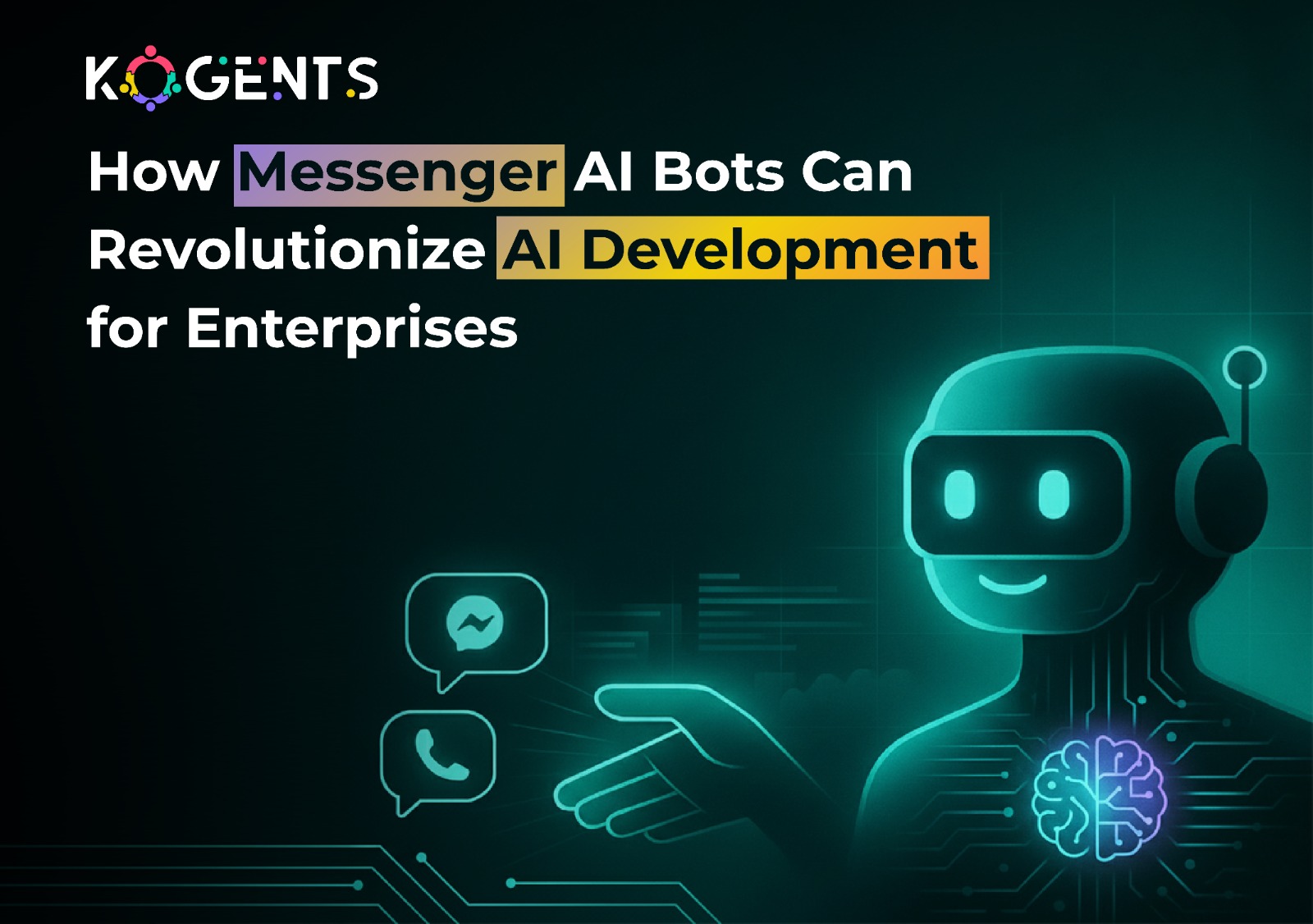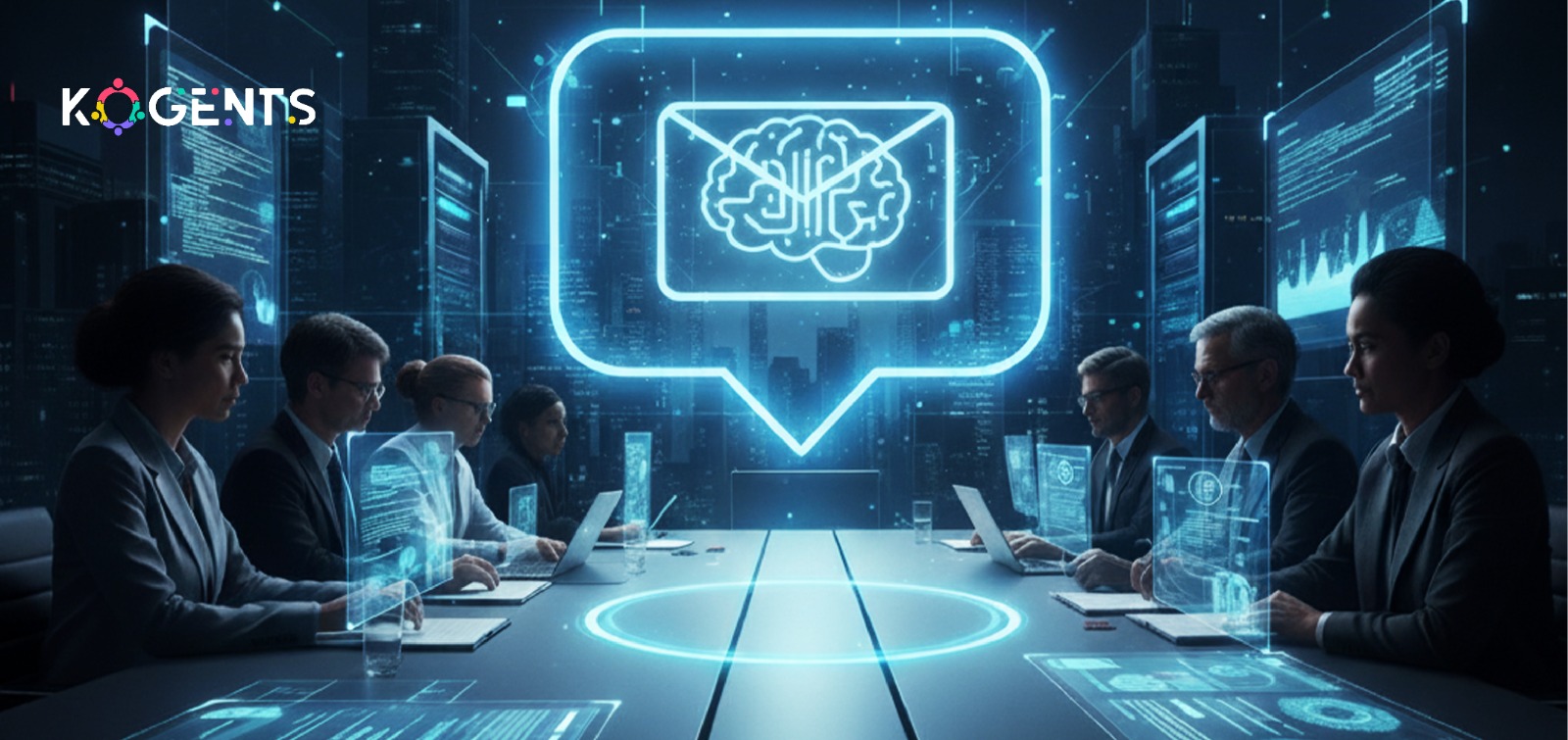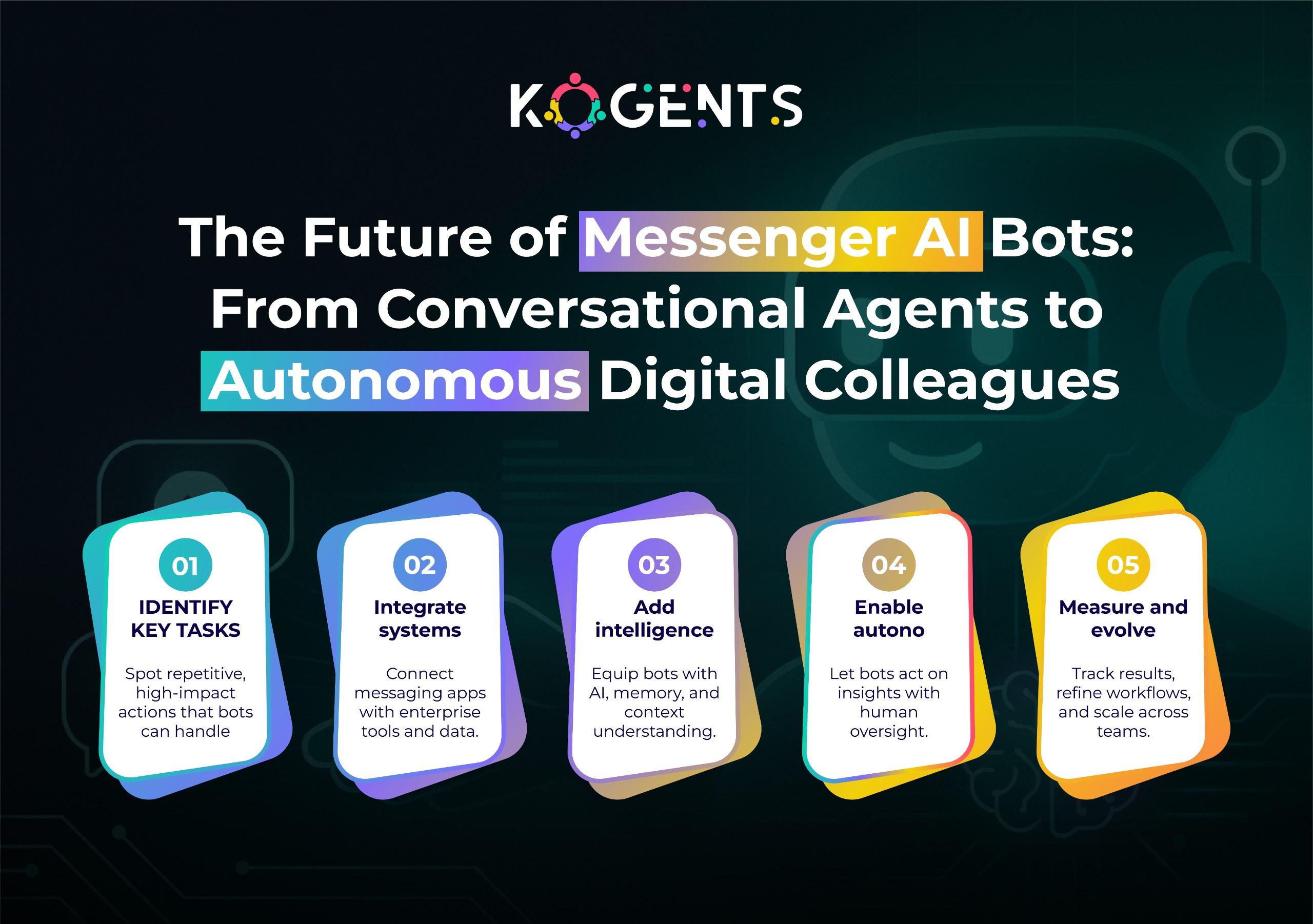How Messenger AI Bots Can Revolutionize AI Development for Enterprises

Summary:
You are well aware of the fact that organisations are burdened with complex tasks: integrating NLP, LLMs, multimodal data streams, legacy systems, and stakeholder demands for speed, scalability, and reliability.
But, this game changer, Messenger AI Bots, intelligent, conversation-driven agents built on messaging platforms, has the capability to expedite and transform enterprise AI workflows.
Imagine development teams interacting with bots via familiar messaging channels, asking questions like “Deploy model X to staging,” or “Fetch latest training logs,” or even “Initiate feature-store refresh”, and receiving real-time responses, automated actions, visual analytics, and human-agent hand-offs, all via chat.
The result? A dramatic shift from slow, siloed development cycles to fluid, conversational, cross-functional collaboration.
In this post, we’ll explore how Messenger‐driven AI bot solutions for enterprise development and automation can revolutionise enterprise AI development.
Key Takeaways
- Harnessing Messenger AI Bots offers real-time collaboration and automation across AI development workflows.
- They bridge developer productivity, conversational UI, and system integration (CRM, ERP, DevOps).
- Proven enterprise implementations show measurable gains, faster time-to-model, lower costs, and higher user adoption.
- The architecture blends conversational AI, intent recognition, dialogue management, and backend orchestration.
- A systematic roadmap is critical: align business use-cases, define KPIs, pick the right platforms, design for compliance, and iterate.

Why Messenger AI Bots Matter for Enterprise AI Development?
Enterprises are under pressure on multiple fronts: rapid deployment of AI solutions, democratization of AI, need for collaboration between data scientists, developers, business stakeholders, and operations teams, integration with enterprise systems (CRM, ERP, HR, ITSM), and the necessity for governance, compliance, and security.
Traditional development tools, IDEs, Jupyter notebooks, command-line tooling, and dashboards do not inherently provide conversational or cross-team orchestration.
This is where “enterprise AI development with Messenger chatbot platforms” makes a difference.
Let’s look at key reasons:
1. Conversational Interface for AI Workflows
- Messenger AI bots provide a natural language interface for technical and non-technical users alike.
- Developers can execute tasks, raise alerts, retrieve logs, and trigger retraining, all via chat. Business users can ask high-level questions like “What’s our model accuracy for Q3?” without needing to access dashboards.
- This boosts accessibility and accelerates adoption.
2. Integration with Enterprise Systems
- These bots can integrate with enterprise infrastructure, CI/CD pipelines, DevOps tools (Jenkins, GitLab), data platforms (feature stores, ETL), CRM/ERP (e.g., Salesforce, SAP SE), HR systems, and ServiceNow.
Example: a messenger bot could greet a new employee, trigger profile setup, access training logs, and escalate to human HR if needed.
- That integration reduces friction and aligns AI development with enterprise workflows.
3. Automation of Repetitive and Rule-Based Tasks
- Many AI development tasks are routine and repetitive: data ingestion, feature generation, model evaluation, deployment, monitoring, and anomaly detection.
- A bot can automate these via commands like “Run feature-store refresh” or “Deploy version 1.2 to production”.
4. Scalability & Multi-Channel Reach
- Messenger bots aren’t limited to one interface; they can span multiple channels like Facebook AI Messenger and others.
- Enterprises can meet developers where they live: in chat.
- Further, since messaging platforms support rich media, bots can surface dashboards and logs directly in the conversation.
5. Analytics & Feedback Loops
- Building feedback loops is essential for AI lifecycle management, tracking model drift, user feedback, error reports, and logs.
- A conversational bot can collect feedback (“Did this model prediction make sense?”) and push that into monitoring pipelines.
- This builds a tighter loop between deployment and improvement.
6. Democratizing AI and Collaboration
- AI development shouldn’t live within silos of data science alone.
- With messenger bots, business users, domain experts, and even frontline workers can interact with AI workflows, but within governance guardrails.
Example: a sales manager asks, “Which regions need model retraining?” and the bot pulls insights from the analytics engine.
Note: This fosters cross-functional collaboration.
7. Cost Efficiency & Speed to Market
Thus, leveraging messenger bots to streamline AI workflows is more than convenience; it’s becoming a competitive imperative.
Architecture & Key Components of Messenger AI Bots for Enterprise AI Workflows
For enterprises looking to adopt an “AI messenger bot’’ in enterprise development workflows,” it’s essential to understand the architecture and key components.
Let’s break them down:
Conversational Layer
- Messaging Platform / Channel: e.g., Facebook Messenger (via Meta Platforms’s Bot API), Slack, Microsoft Teams.
- Bot Engine / Conversational AI: Manages the dialogue: intent recognition, entity extraction (via NLU), dialogue management, context tracking, multi-turn conversation handling.
- Natural Language Understanding (NLU) & Dialogue Manager: For enterprise bots, NLU must handle domain-specific vocabulary and maintain context across turns.
- Response Generator / Workflow Adapter: Based on intent, triggers backend workflows (e.g., pull metrics, run training job).
- Human-agent Handoff: For queries beyond the bot’s scope, escalate to human specialists.
Early research shows that Messenger added bot framework support in April 2016.
Backend Integration Layer
- API Connectors: Connect to CI/CD tools, ML workflow orchestration logs/monitoring tools, feature stores, data warehouses, CRM/ERP systems.
- Orchestration Layer: Manages tasks, triggering pipelines, scheduling jobs, retrieving results, or monitoring statuses.
- Knowledge Base / Model Repository: Stores documentation, metadata, model versions, and feature lineage. The bot can fetch from this knowledge base to answer “Which model version is deployed in production?”
- Analytics & Logging: Track bot interactions, monitor workflow performance, and deploy regular reports back through the bot.
Security, Compliance & Governance
- Authentication & Authorization: The bot must enforce enterprise identity (SSO), role-based access.
- Audit Logs & Change History: All bot-triggered actions (model training, deployment, data refresh) must be logged for governance.
- Data Privacy & Compliance: Messaging channels may transfer sensitive information; encryption, data residency, and access controls must be addressed.
- Recovery & Fail-Safe Mechanisms: Since bots may trigger production workflows, fallback to manual control is critical.
Deployment Phases
- Pilot Phase: Choose a high-impact workflow (e.g., model monitoring) and deploy a minimal viable bot.
- Integration Phase: Expand to more workflows, connect to more systems.
- Scaling Phase: Add channels, intelligence (LLMs, multimodal), governance mechanisms.
- Optimization Phase: Analytics-driven improvements, conversational refinements, conversational flows tuned for enterprise vocabulary and human-bot collaboration.
Use Cases & How Enterprises Leverage Messenger AI Bots
Let’s explore how enterprises are using messenger AI bots to accelerate AI development, along with concrete scenarios.
Use Case 1: Self-Service for Non-Technical Stakeholders
- HR or sales teams can query: “When is the next model refresh scheduled?” or “Send me last month’s model performance summary.”
- The bot retrieves the information, pushes results or dashboards, and supports decision-making without waiting on the AI team.
Use Case 2: Alerting & Incident Management
- When production model inference drops below SLA, the bot posts in chat: “Alert: ChurnModel_v1 recall dropped by 10% vs baseline.
- Would you like me to trigger retraining?” The dev team can respond via chat, and the bot orchestrates remediation.
Use Case 3: Cross-Channel Omni-Presence
Bots deployed via Slack for developers, Microsoft Teams for business users, and WhatsApp for field agents ensure the same conversational interface is leveraged across roles.
This aligns with the trend toward “omnichannel support”.
Used Case Studies of AI Bots
Case Study: Conversational Design’s Lead-Conversion Bot
An agency used a bot on Facebook Messenger to automate lead capture, engaging users via chat rather than forms.
The result: Lead conversion increased by 40%, cost per lead dropped, and waiting times reduced markedly.
Relevance: Highlights chatbot integration and conversational flows in a business workflow context, which can be mapped to AI development workflows.
Case Study: Enterprise Bot in the Financial Sector
A fintech company built an “Enterprise Bot”, a digital interaction tool for customers and internal users.
The bot handled instant answers across messaging channels and streamlined engagements.
Relevance: This shows internal-enterprise usage, which is critical when repurposing messenger bots for internal AI development support.
Case Study: Messenger Bot Research for Business Applications
A study on “Facebook Messenger bots and their application for business” outlines the framework, benefits, and challenges of messenger-bot integration in organisational workflows.
Relevance: Though academic, it underscores the head-start available for messenger bot adoption frameworks.
Traditional AI Tooling vs Messenger AI Bot-Driven Workflow
| Metric | Traditional AI Tooling | Messenger AI Bot-Driven Workflow |
| Access interface | Developer IDEs, dashboards, CLI only | Conversational interface (chat) for devs, business users, operations |
| Task initiation | Manual triggers, siloed workflows | Command via chat, easy orchestration |
| Collaboration | Separate systems for dev, business, ops | Unified conversational UI across roles |
| Workflow visibility | Requires dashboards or portals | Bot delivers alerts, logs, and summaries in chat |
| Onboarding speed for non-technical stakeholders | Slow, training-intensive | Rapid via conversational prompts |
| Reaction time to issues | Moderate (manual monitoring) | Faster – real-time alerts + bot triggers |
| Automation of routine tasks | Requires scripts, separate tools | Bot-driven orchestration via chat commands |
| Governance & audit | Disparate logs | Centralised audit trail of bot actions in chat |
| User adoption (non-dev) | Low to moderate | Higher due to conversational interface |
| Time-to-value | Longer | Potentially shorter |

Conclusion
Done well, messenger AI bots are not just productivity tools; they become transformational enablers of enterprise AI programmes.
At Kogents.ai, we specialise in helping enterprises harness Messenger-driven AI bot solutions for enterprise development and automation.
Whether you are building your first AI model, scaling your MLops pipeline, or democratizing AI across business units, we bring expertise in conversational AI integration, enterprise system orchestration, and results-driven workflows.
Contact us to discover how you can accelerate your AI development via messenger bots and gain a competitive edge in the AI-first world.
FAQs
What are messenger AI bots, and how can enterprises use them to develop AI faster?
Messenger AI Bots are conversational agents on messaging platforms that let users interact with enterprise systems via natural language. They enable faster AI development by triggering tasks like model retraining or analytics through chat. This streamlines workflows, reduces delays, and minimizes manual effort.
Why are messenger AI bots key to enterprise AI development strategies?
Because they unify technical execution and business communication through a conversational interface, they reduce barriers between data scientists, engineers, and business users, integrate with enterprise systems (CRM/ERP/DevOps) to automate workflows and orchestrate tasks, accelerate throughput, raise adoption, and enhance governance.
Which enterprises have adopted messenger AI bots for AI development?
While specific examples of messenger bots strictly for AI-model development may still be emerging, enterprises such as Facebook (Meta) themselves used Messenger-based bots for supplier workflows (see the Azumo case). Customer-service bots in enterprise settings are widespread and demonstrate underlying architecture.
Messenger AI bots vs traditional AI development tools in enterprise settings: what are the differences?
Traditional AI development tools rely on IDEs, dashboards, CLI tools, specialist systems and often require context-switching between stakeholders. In contrast, messenger AI bots provide:
- A conversational interface (chat)
- Multi-role access (developers, ops, business)
- Real-time orchestration of workflows
- Integration with messaging channels is widely adopted across enterprise teams.
- Lower learning curve for non-technical users
- Faster reaction time and collaboration
How do you choose a messenger AI bot vendor for enterprise AI projects?
Enterprise Messenger AI Bots offer multi-platform support (Messenger, Slack, Teams), robust NLU, and secure integrations with ML, DevOps, CRM, and ERP systems. They provide scalability, analytics, customization, compliance, and proven enterprise deployments.

Kogents AI builds intelligent agents for healthcare, education, and enterprises, delivering secure, scalable solutions that streamline workflows and boost efficiency.